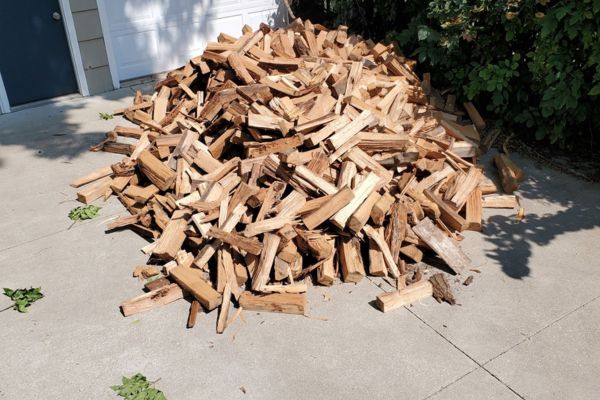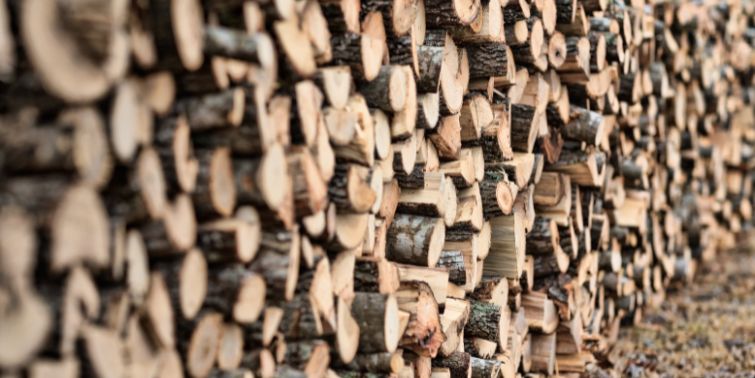If you are shopping for firewood, you’ll likely run across terms like “seasoned” and “kiln-dried.” But what is kiln-dried firewood? More importantly, is it better? Choosing the right fuel source for your fire can mean the difference between hours of slow-burning warmth and a fire that’s difficult to light.
Common questions include, “What are kiln-dried logs?” and “What is kiln-dried wood?” Knowing the answers can help you choose the best option for your fire.
What Does Kiln-Dried Wood Mean?
Freshly cut wood has a relatively high moisture content. That moisture needs to be removed before the wood can burn effectively.
Traditional “seasoned” firewood is left outside to air dry for six months or more. If you live in a humid or cold environment, the wood may take a year or more to dry enough. While this process reduces moisture content, drying is uneven and dependent on the weather.
Kiln drying uses specialized kilns, which are large, heated chambers. They circulate hot air. In just a few days, the moisture drops below 20%, which is the industry standard for clean-burning wood.
What if the Moisture Content Is Too High?
If you go with seasoned wood that wasn’t dried properly, it may have too much moisture. When that happens, the wood will be difficult to ignite. You’ll likely need to use kindling or fire starters just to get it going.
Once it does burn, much of the energy goes toward turning water into steam rather than producing heat. That means cooler fires and shorter burn times.
Excess moisture also creates heavy smoke. If you are burning the wood inside a fireplace, you’ll deal with poor indoor air quality and faster creosote buildup inside your chimney. That can create a major fire hazard without proper maintenance. High-moisture logs often crackle and hiss as trapped water boils out.
On the other hand, kiln-dried firewood avoids all of these issues by maintaining a consistent moisture content below 20%. The result is hotter, cleaner, and safer fires every time.
What Is a Kiln for Wood?
A kiln for firewood is an industrial oven designed to remove moisture from lumber or logs. Kilns are used for construction lumber, furniture production, and flooring, too.
Typically, operators will increase the temperature of the kiln in stages. They will also adjust the equilibrium moisture content (EMC) and relative humidity. When the moisture content of the wood is very high, the kiln will typically be set at around 110 degrees Fahrenheit.
As the moisture decreases below the 30% range, the kiln temperature will be increased to 120 degrees Fahrenheit. During the final stage, the kiln will be increased to 140-160 degrees Fahrenheit. The EMC and relative humidity are adjusted down as well.
Reputable providers will test the moisture level of the firewood to ensure it is adequately dry. The target range is approximately 15% humidity.
What Does Kiln Drying Do to Wood?
When you dry wood in a kiln, it turns into a fuel source that burns hotter, cleaner, and safer than almost any other option.
Freshly cut logs are heavy with water, often holding 40-60% moisture. That water makes ignition difficult and forces the fire to waste energy evaporating moisture. You also have to worry about popping and crackling, which could send hot ashes or sparks your way.
The kiln chamber exposes logs to steady heat and airflow for several days. As water leaves the wood and the settings in the kiln are adjusted, the logs will stabilize at around 15-20% moisture content. The result is logs that will be much easier to light, and they will burn cleaner.
A single kiln-dried log will deliver a longer fire than a poorly seasoned piece of wood of a similar size.
Another critical benefit is bug elimination. All sorts of pests can hunker down in firewood, including bark beetles, ants, and termites. Seasoning won’t kill off these bugs. They may even infest your home or shed.
The high heat inside the kiln kills pests at every stage of life. Your wood will be safe to store indoors or outside near your living space.
The process also produces a cleaner surface. Mold spores and fungi thrive in damp woodpiles. When your logs are dried in the open air, mold can take hold before the wood is ready to burn. The kiln will kill mold and leave behind logs that are healthier to burn indoors.
What is the Difference Between Kiln-Dried and Seasoned Firewood?
When shopping for firewood, you’ll come across seasoned and kiln-dried options. While both can be a good fit for your fire, some important differences make kiln-dried logs better.
One of the biggest differences is drying time. Seasoned wood is stacked outdoors and left to dry naturally for six months to a year and a half, depending on the climate. If you buy your logs from a local provider that didn’t adequately dry them, you may run into difficulties lighting your fire.
Kiln-dried logs can be ready to burn in just 3-7 days. That speed means kiln-dried firewood is readily available when you need it, no matter the season.
Kiln-dried wood consistently reaches 15-20% moisture content, which is considered ideal for combustion. Seasoned firewood varies widely, with properly seasoned logs ranging from around 25%-35%. If the stack wasn’t protected from the weather, it could have an even higher moisture content.
One of the biggest drawbacks of seasoned firewood is that it’s constantly exposed to the elements. Piles of logs attract insects and can harbor mold. Kiln-dried firewood avoids these problems by killing any pests, fungi, or mold. It arrives clean, dry, and ready to burn.
You can also store kiln-dried wood in your garage or indoors. While you can technically store seasoned wood inside, you have to be cautious of mold or pests. You don’t want to bring an infestation into your house or shed.
The bottom line is that kiln-dried wood is simply better, cleaner, and easier to ignite. It’s easily the best choice when ordering logs for your next fire.
What Is Kiln Wood?
Kiln wood simply refers to any wood that has been dried in a kiln. It most commonly means firewood that has been treated to lower the moisture content to optimal levels. However, wood used for furniture and flooring may also be dried in a kiln.
Going with kiln-dried wood means you will have a fire that lights quickly on cold winter nights and produces steady, dependable heat. If you are sourcing wood for cooking, kiln logs will deliver a more consistent flavor and temperature in your oven. Unlike air-dried logs that vary from batch to batch, kiln wood offers uniform results every time.
Kiln wood is also popular for people who want the convenience factor. With kiln wood, there’s no need to plan months in advance. You won’t have to cut, split, stack, and air dry your logs for months. Simply order what you need and start burning right away. That makes kiln wood particularly appealing if you are limited on space and time.
 Common Uses of Kiln-Dried Firewood
Common Uses of Kiln-Dried Firewood
Are you thinking about ordering some kiln wood for your next fire? Here are some common use cases:
- Home Heating: Wood stoves and fireplaces will reach higher temperatures with less effort when you use properly dried logs
- Cooking: Restaurants with pizza ovens and homeowners with smokers prize kiln-dried wood for consistent burn and flavor
- Outdoor Living: Backyard fire pits benefit from quick-starting, low-smoke fires that keep gatherings comfortable
- Camping: Thoroughly dried kiln logs ensure your next campfire lights right up
These are just a few of the top use cases for kiln-dried firewood. When you want logs that will light right up and burn cleanly, go with kiln-dried fuel sources. Everyone gathered around the fire will thank you.
Why Kiln-Dried Firewood Is the Best
When comparing firewood options, kiln-dried wood consistently wins. While convenience is a major factor, it’s just one of the perks. Other benefits include:
- Reliable Ignition: Fires light easily without endless kindling or firestarters
- Higher Heat: Logs will burn hotter because they won’t be getting rid of excess moisture
- Cleaner Burn: Less smoke and creosote help keep your chimney clean and your outdoor fires more enjoyable
- Eco-Friendly: Efficient combustion lowers emissions compared to damp logs
- Convenience: Delivered dry, clean, and bug-free
The benefits of kiln-dried wood are undeniable. Now, all you need to do is find a reliable provider.
Ready to Upgrade Your Firewood?
Now that you’ve unpacked the question, “What is kiln-dried firewood?” it’s time to order some logs for your next fire.
ProCut Firewood has a huge selection of firewood and cooking wood. We sell logs in several different volume options so you can get the ideal amount of fuel for your next fire. Contact us to place your order. Pick up onsite or schedule a delivery.







